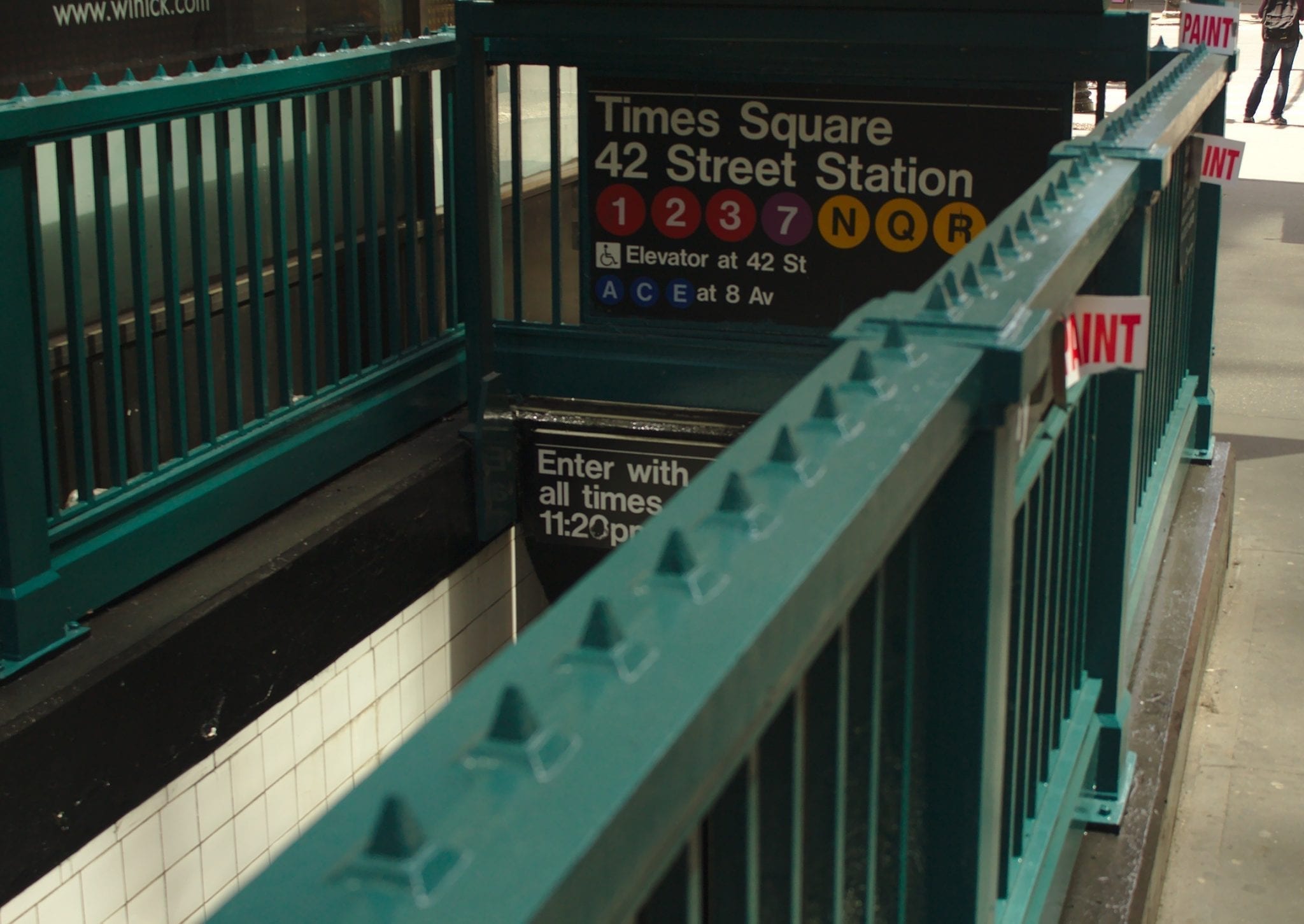Never before has the Capital Program mandated a minimum, let alone such a significant investment, in making stations accessible to people with disabilities.
Disability advocates in New York today signed a settlement agreement that will make the New York City subway accessible for more than half a million people with disabilities who cannot use stairs to access the system. Today only 25% of stations (113 stations) have elevators or ramps and are usable by people with disabilities affecting their mobility. Full text of the Settlement Agreement will be posted on Disability Rights Advocates’ website when finalized.
Center for Independence of the Disabled, New York (CIDNY), Brooklyn Center for Independence of the Disabled (BCID), Bronx Independent Living Services (BILS), Harlem Independent Living Center (HILC), Disabled In Action of Metropolitan New York (DIA), New York Statewide Senior Action Council (“StateWide”), Sasha Blair-Goldensohn, Dustin Jones, Jessica De La Rosa, and Jean Ryan have, with the Metropolitan Transportation Authority, signed a Settlement Agreement that will make accessible at least 95% of the NYC subway’s 364 currently inaccessible stations by 2055. This is a landmark achievement because only 113 stations have been made accessible since the subway was built in 1904.
The Settlement Agreement provides that the MTA commits to dedicating 14.69% of each of its 5-year Capital Plan budgets to station accessibility, barring unexpected critical needs. Should such unexpected needs arise, the MTA commits to devoting no less than 8% of its total Capital Plan to station accessibility. Never before has the Capital Program mandated a minimum, let alone such a significant investment, in making stations accessible to people with disabilities. Additionally, the Agreement ensures that stations will be made accessible as part of many renovation and rehabilitation projects. In total, the MTA commits that in addition to the 81 stations currently slated for accessibility in the 2020-2024 Capital Program, 85 more stations will be accessible by 2035, another 90 by 2045, and the final 90 by 2055.
CIDNY, BCID, BILS, HILC, DIA, StateWide, Mr. Blair-Goldensohn, Mr. Jones, Ms. De La Rosa, and Ms. Ryan are Plaintiffs in two lawsuits brought against the MTA by Disability Rights Advocates (DRA) and Sheppard, Mullin, Richter & Hampton LLP (Sheppard Mullin). The first lawsuit, filed in 2017 in New York State Supreme Court, alleges violations of the New York City Human Rights Law because of the vast inaccessibility of the current subway system. Read the complaint here. Last year, the Court appointed Plaintiffs representatives for a certified class of all people with disabilities affecting their mobility who are unable to access the subway. The second lawsuit, filed in 2019 in federal court in the Southern District of New York, alleges that the MTA consistently renovates and rehabilitates subway stations without adding stair-free access as part of those renovations. Read the complaint here. This Settlement Agreement will resolve both lawsuits and the settlements must be approved by both Courts before it takes effect.
“It is my pleasure as an advocate for accessibility, after decades of advocacy and hard work by disability-related stakeholders, to celebrate the commitment to access for all who use New York City’s subway system operated by the MTA. Everyone who lives, works, or visits New York City and our amazing state will benefit from the promise of universal access that our work with the MTA on this settlement agreement will afford our community,” said Dr. Sharon McLennon-Wier, Ph.D., CRC, LMHC, Executive Director of Center for Independence of the Disabled, New York. “This took a collaborative approach and dedication by numerous disability advocates who envisioned a more accessible city for all New Yorkers.”
“Hallelujah! Finally, some good news!” said Joe Rappaport, Executive Director of Brooklyn Center for Independence of the Disabled. “This extraordinary agreement ensures that no one will be shut out of the fastest, best way to get around town. For BCID, like the other plaintiffs and our attorneys, this is the culmination of years of advocacy, both in and out of the courtroom. We’re immensely proud we and the MTA have reached this day.”
“Today is a historic day for individuals with disabilities. Future generations will now be able to say that we have a fully accessible subway system. We will all be able to go anywhere in the five boroughs allowing us to participate in all New York City has to offer,” said Brett Eisenberg, Executive Director of Bronx Independent Living Services. “BILS is grateful to all the other plaintiffs in the case as well as our attorneys at DRA and Sheppard Mullin. We thank the MTA for recognizing the importance of a fully accessible subway system. We look forward to implementation of this agreement to make the subway system accessible as fast as possible.” Watch a video of Brett Eisenberg sharing the importance of this historic settlement.
“The Harlem Independent Living Center is pleased and excited to be part of this historic achievement regarding the MTA and assisting in making the subway transit system accessible to the disabled community and to everyone in general,” said Christina Curry, Executive Director of Harlem Independent Living Center. Watch a video of Christina Curry sharing the importance of this historic settlement.
“Disabled In Action has fought to eliminate barriers to full equality for people with disabilities for more than 50 years, and is proud to do so here on behalf of all New Yorkers,” said Jean Ryan of Disabled In Action New York. “All our members need elevators in the subways, and we need elevators in all stations. Elevators are for everyone.” Watch a video of Jean Ryan sharing the importance of this historic settlement.
“Transportation Accessibility is one of the most important issues for the community, NYC’s leaders and people with disabilities. Given the fact that the within 4 short years close to 25% of NYC’s population will 65 years of age and over, these improvements to the subways cannot come soon enough,” said Maria Alvarez, Executive Director of StateWide. “We must continue striving toward an age-friendly New York City which will make it a city conducive to the comfort and ease for all.”
“This settlement builds on decades of disability rights work, by countless advocates, activists and allies. People like Rise and Resist Elevator Action Group, rallying at every hearing, from courthouse steps to MTA board meetings — you all made a difference,” said Sasha Blair-Goldensohn, who uses a wheelchair. “We’re grateful, humbled, and can’t wait to ride together.” Watch a video of Sasha Blair-Goldensohn sharing the importance of this historic settlement.
“This is a good day for the disability community. Without a robust accessible transportation system, people will be limited on where they go as far as work, recreation, shopping, school and even where they live,” said Dustin Jones, who uses a wheelchair. “DRA and Sheppard Mullin share that same vision and I am lucky they were on the case to bring access where we didn’t have it before. Access is a civil right and we will continue to fight for it for as long we have fire and desire in our hearts and air in our lungs.”

“I’ve been waiting for this moment since I was 15 years old,” said Jessica De La Rosa, who uses a wheelchair. “I am thrilled that the subways will be more accessible for the next generation of 15-year-old disabled children to ride the subway in their city like every other New Yorker. But it doesn’t stop here MTA, let’s keep going!”
“Disability Rights Advocates is honored and privileged to represent these trailblazing activists who have secured a more just and accessible future for everyone who uses the subway,” said Torie Atkinson, Staff Attorney at Disability Rights Advocates. “We look forward to working with the MTA to swiftly implement these commitments.”
“This landmark agreement brings to a conclusion decades of advocacy by the disability community and our clients for equal access to New York City’s critical subway system,” said Daniel Brown, Partner at Sheppard, Mullin, Richter & Hampton LLP. “I’m so proud to say we achieved our goal and future generations of New Yorkers will be able to enjoy the benefits of our subway system.”
About Bronx Independent Living Services (BILS):
Founded in 1983, Bronx Independent Living Services (BILS) is a consumer-based, non-profit organization providing services and advocacy for independent living for individuals with disabilities. BILS’s mission is to ensure full integration, independence, and equal opportunity for all people with disabilities by removing barriers to the social, economic, cultural, and civic life of the community. For more information, visit www.bils.org.
About Brooklyn Center for Independence of the Disabled (BCID):
The Brooklyn Center for Independence of the Disabled, founded in 1956, is part of the independent living movement, which seeks to empower all people with disabilities to live full, independent lives. Our staff, composed largely of people with disabilities, offers services and runs advocacy campaigns to make housing, transportation and other aspects of daily living accessible to all. For more information, visit www.bcid.org.
About Center for Independence of the Disabled, New York (CIDNY):
The Center for Independence of the Disabled in New York is a leading advocate for people with disabilities in New York City. It was founded in 1978 to ensure full integration, independence and equal opportunity for all people with disabilities by removing barriers to the social, economic, cultural and civic life of the community. For more information, visit www.cidny.org.
About Disabled In Action of Metropolitan New York (DIA):
Founded in 1970, Disabled in Action of Metropolitan New York is a democratic, nonprofit membership organization consist primarily of and is directed by people with disabilities. DIA is a civil rights organization committed to ending discrimination against people with disabilities. DIA fully embraces the empowering motto “Nothing about us, without us!” For more information, visit www.disabledinaction.org.
About Disability Rights Advocates (DRA):
Disability Rights Advocates is one of the leading nonprofit disability rights legal centers in the nation. With offices in Berkeley, California and New York City, DRA’s mission is to advance equal rights for people with all types of disabilities nationwide. DRA’s work in New York City has resulted in making half of the City’s yellow taxi fleet accessible to wheelchair users, a federal court order requiring the City to make its voting sites accessible, and a victory at trial in a class-action lawsuit challenging New York City’s failure to plan for the needs of persons with disabilities in disasters such as Hurricane Sandy. More information can be found at www.dralegal.org.
About Harlem Independent Living Center (HILC):
Harlem Independent Living Center was incorporated on May 31, 1990 to provide access to independent living services to these un-served and underserved individuals and to expand the system of independent living available to all New Yorkers. HILC assists the communities of people with disabilities in achieving optimal independence through culturally and linguistically appropriate services by advocating, educating, empowering and being a community change catalyst. For more information, visit www.hilc.org.
About New York StateWide Senior Action Council:
Founded in 1972, StateWide’s mission is to achieve through united action the dignity, well-being and security of all senior citizens of New York State. StateWide is a grassroots membership organization of individual senior citizens and senior citizen clubs throughout New York State. StateWide works to achieve its mission through trainings, educational workshops, legislative advocacy, direct consumer assistance, and monitoring programs and services for the elderly of New York State.
About Sheppard, Mullin, Richter & Hampton LLP:
Sheppard Mullin is a full-service Global 100 firm with more than 900 attorneys in 15 offices located in the United States, Europe and Asia. Since 1927, industry-leading companies have turned to Sheppard Mullin to handle corporate and technology matters, high-stakes litigation and complex financial transactions. In the U.S., the firm’s clients include almost half of the Fortune 100. For more information, please visit www.sheppardmullin.com


Join the conversation!